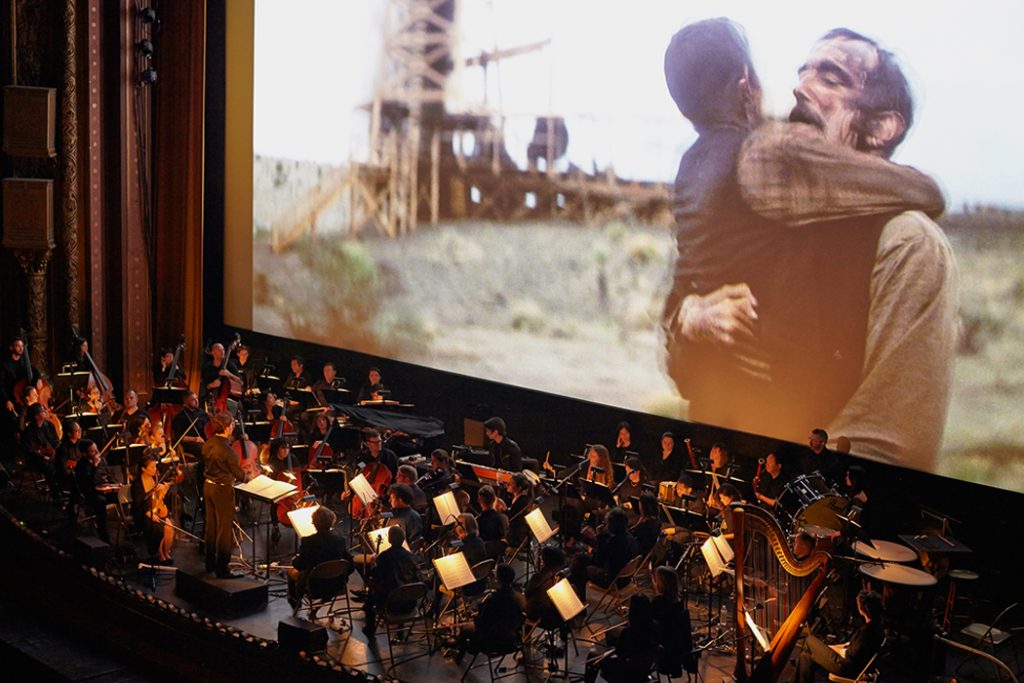+ Soundfly’s Intro to Scoring for Film & TV is a full-throttle plunge into the compositional practices and techniques used throughout the industry, and your guide for breaking into it. Preview for free today!
If you ask most musicians who Jonny Greenwood is, they would probably take a few seconds to respond. You might have to prompt them with a single word to jog their memory: “Radiohead.” As Greenwood (b. 1971) has spent the majority of his almost 30 years in music behind one of rock’s greatest frontmen, he doesn’t always get the same level of name recognition as Mr. Yorke, despite working overtime as one of the members of Radiohead most responsible for sculpting their unique sound and compositional style.
These days, Greenwood’s work spans a huge range of genres. He’s come into his own as a singular performer of Reichian minimalist guitar and electronics, a programmer of electronic synthesis in Max MSP, a practitioner of the eery and rare 1928 instrument, the ondes martenot, and a composer and arranger for orchestral works.
His endeavors as a composer for orchestra date back to his first major work, Smear (2004) for two ondes martenots and chamber ensemble, and his seminal Popcorn Superhet Receiver (2005) written for the BBC concert orchestra and inspired by the dissonance-heavy work of composer Krzysztof Penderecki.
Although Greenwood has worked with many filmmakers at this point, he is mostly known for his film music through his various collaborative efforts with director Paul Thomas Anderson, having scored his films: There Will Be Blood (2007), The Master (2012), Inherent Vice (2014) and Phantom Thread (2017).
Today, we’re only going to look at a handful of cues from two of his Anderson scores — his earliest, There Will Be Blood, and his latest, Phantom Thread. In the following article, we will take a look at how Greenwood employs some of his go-to compositional tools in film music: specifically, the use of clusters, aleatoric techniques, and extended techniques, as well as his focus on sonic materiality and texture.
There Will Be Blood
This film tells the story of Daniel Plainview, a prospector who spends his life looking for lands from which he can extract oil. The film has an ominous essence to it, exploring themes surrounding man’s injurious relationship to the environment — exploiting the land to extract what flows inside. I would like to start with musical cues from this score that showcase some of the typical features appearing in Greenwood’s scores and how they emotively reflect back to the film. Let’s listen to “Henry Plainview,” a cue that appears about half way into the film.
This cue is scored for string orchestra and is written individually, rather than grouping the strings in sections with divisi. Here, and in the following extracts, I have made some reductions to better display the techniques at stake.
Greenwood uses a dense cluster for this cue, spanning one octave and starting from C in the uppermost violins (“Vln 1”) to the same note an octave below in the cello (“Vlc”). Every pitch in the chromatic scale is assigned individually to the single instruments, and the culmination is a shapeshifting drone.
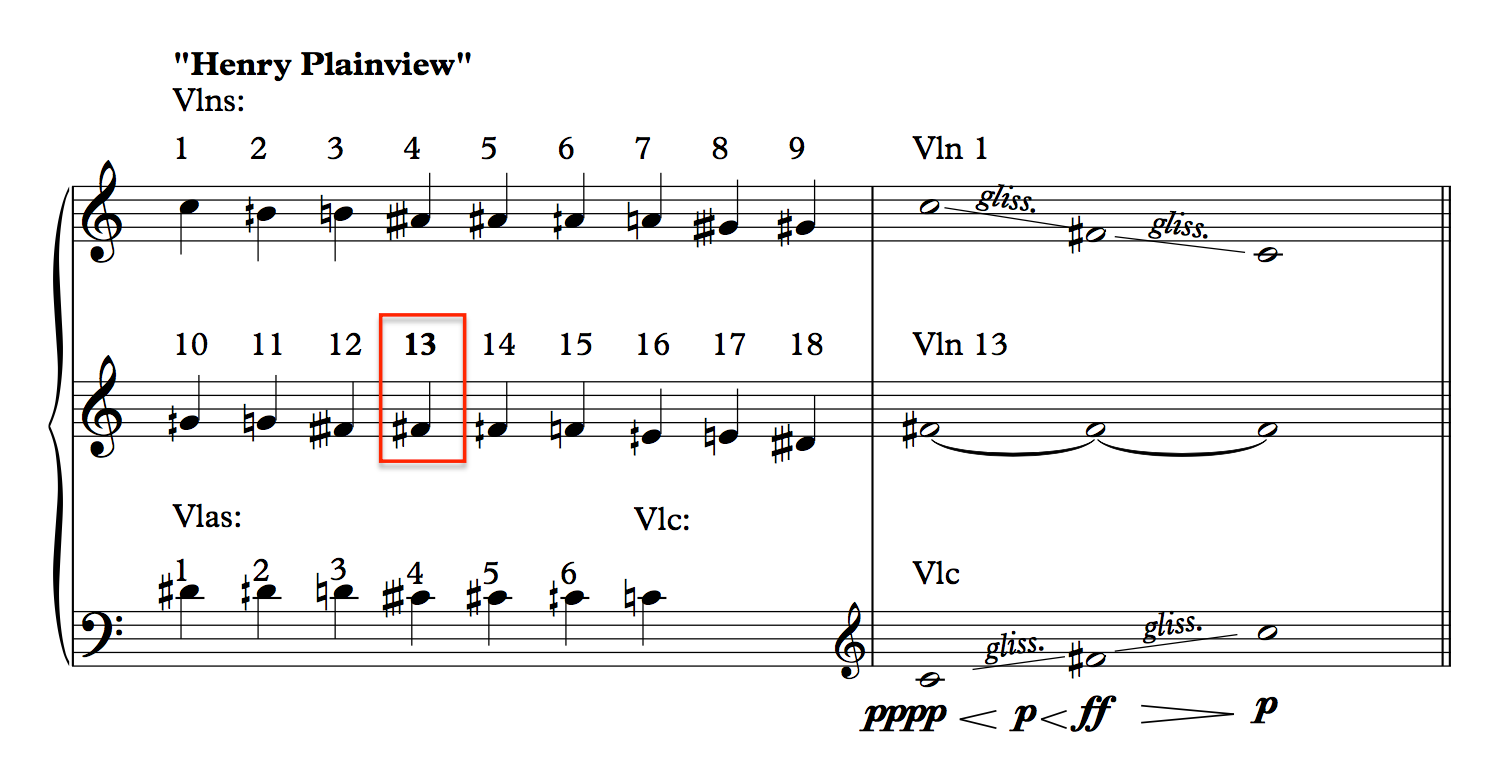
If we take a closer look at “Vln 2,” notated with a demisharp, we start to realize that microtonal increments, in this case a raised quarter tone, are being used quite freely. “Vln 4,” notated with a sesquisharp (or “sharp-and-a-half”), raises the note by three quarter tones, creating a note midway between A# and B. Greenwood uses the microtonal fluidity of the string section to create a dissonant, dense cluster, which in the end takes the orchestra outside of sounding “musical” entirely; offering instead a textural sonic element reflective of the “oil mud” in the landscape.
The cluster is held at a very quiet dynamic and is played with a crescendo plus glissando at the same time, reaching a fortissimo and then easing out on a piano again. Whilst acting on changes of dynamics, the strings also perform a glissando, a particular one: all pitches converge to F#, actually converging to the note assigned to “Vln 13” right in the middle of the cluster, and then continuing the glissando in the same direction.
One would expect the cluster to return back to their original pitches, but what happens here is another hint at variety: The highest voice in the pppp cluster becomes the lowest voice in the ff cluster and vice versa. All the pitches in between also follow the same principle, rotating on the central axis of F# (which is played and held by “Vln 13”). This technique is employed to give inner movement to the cluster, which otherwise would sound just as a mass of clashing pitches and partials.
These dipping glissando cycles could communicate a few different things in film music — a fall from grace, a drunken stupor — but here, I can’t seem to visualize anything but the slow up and down movement of a pumpjack extracting oil from deep in the ground. As the music sinks down, so we are brought into this landscape of space above and below the surface of the earth.
The second cue I want to look at, which is first cue of the soundtrack, “Open Spaces,” shows Greenwood’s taste for aleatoric techniques in string writing, used this time in conjunction with the use of motif. (Aleatoric technique refers to the use of randomness or random choice by the performers).
Here, the initial rise of a perfect fifth in the lower strings is answered by the higher instruments, accompanied by ondes martenot, a pioneering electronic instrument, quite similar to the theremin but touch-sensitive (whereas a theremin is played without touch), but also set into a keyboard frame.
In bar 3 of the following example we can see how the upper instruments respond with two superimposed triads (G and D minor) over a pedal in A. This extract is in D Dorian and it’s curious how the superimposing triads create a sort of diatonic cluster, spanning from D3 to D4 and covering almost all the pitches in the Dorian scale (except for C). This is further enriched by a crescendo and diminuendo in the dynamics.

Moreover, note the indication at the top of the reduction, which instructs the players to randomly change the movement of the bows, to create an aleatory effect. This effect makes some of the notes in the voicing poke out more than others at each random change of bow, creating a musical analogy to the gushes of oil springing from the land.
This score is filled with connections between the materiality of the sounds and the grainy, muddy, and bleak nature of the landscape. Specifically, the dual employment of materiality and tone clusters has been used to great effect in film scoring in the past. If you remember the famous “shower scene” in Hitchcock’s Psycho (1960), whereby composer Bernard Herrmann uses slashing sforzati in the strings to accompany the intensity of the stabbings, along with dissonantly clustered minor second intervals.
In Jaws (1970), John Williams needed a motif to articulate the sharpness of a shark’s teeth, so guess which interval he chose to emulate that anxious, biting feeling… Minor seconds, the founding “bricks” of clusters.
Another way that Greenwood uses aleatoric compositional techniques can be seen in a second example from the same cue, “Open Spaces.”
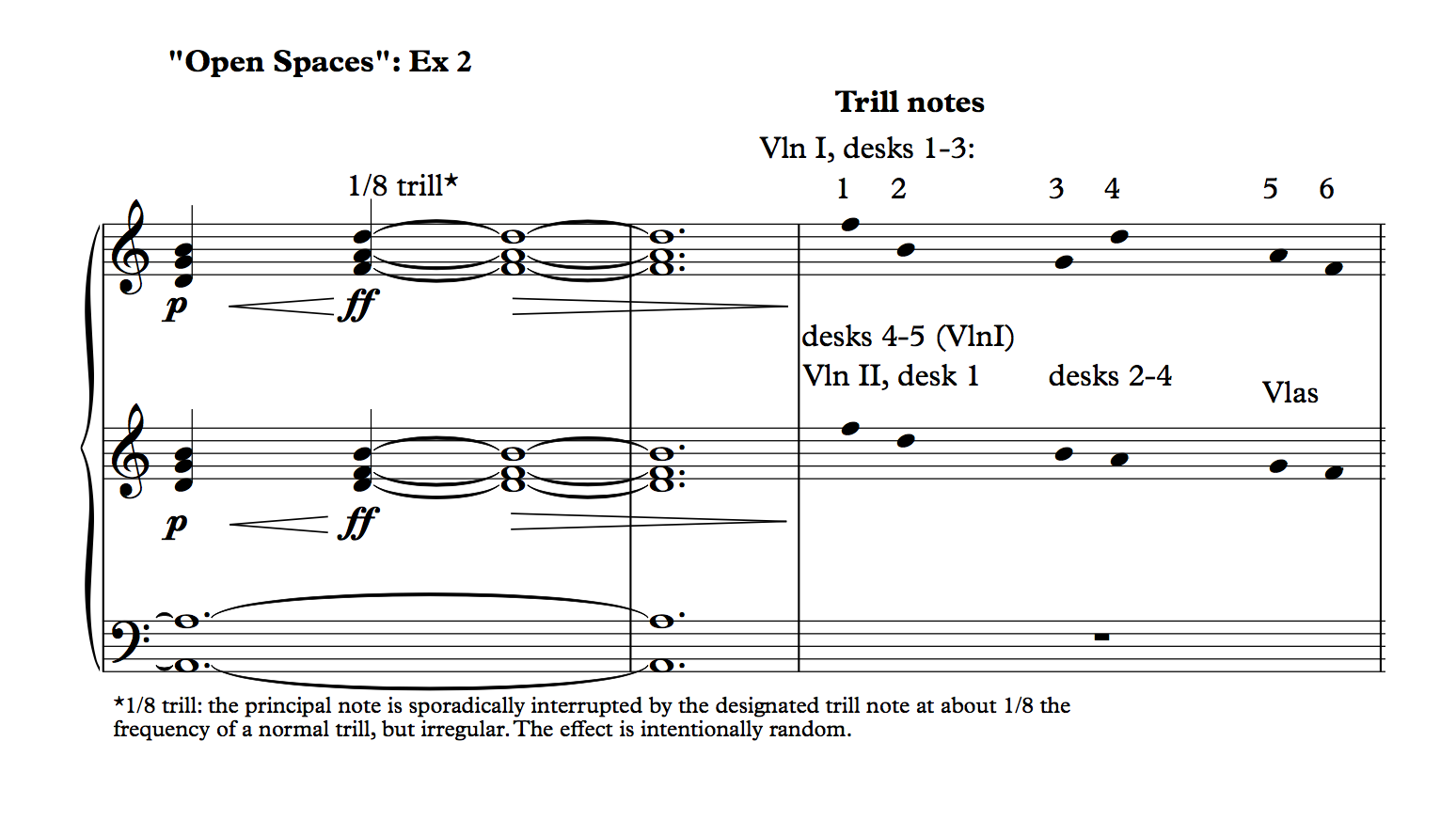
Here, the score instructs the musicians to play peculiar trills. These are assigned to different players in different “desks” and they are subject to chance techniques. As can be read in the instruction to the players, he denotes that this sporadic “effect is intentionally random.” Although diatonic here, the aleatoricism puts an emphasis on the players in the orchestra and the performance as a work of time-based art, as opposed to the prevailing role of the film score in Hollywood, which is to be background music. In Anderson’s films, the music is a character unto itself.
We’ll look at one more cue from this film. The cue “Proven Lands” comes about when Plainview is looking for new land from which to extract oil.
This cue is scored for string orchestra and makes use of extended techniques. Firstly, as we can see in the example below, there are three main lines: a melodic line, played with plectrum, a percussive muted line, also played with plectrum, and a double bass line which makes use of pizzicato, glissando, and percussive effects such as fingerboard slap.
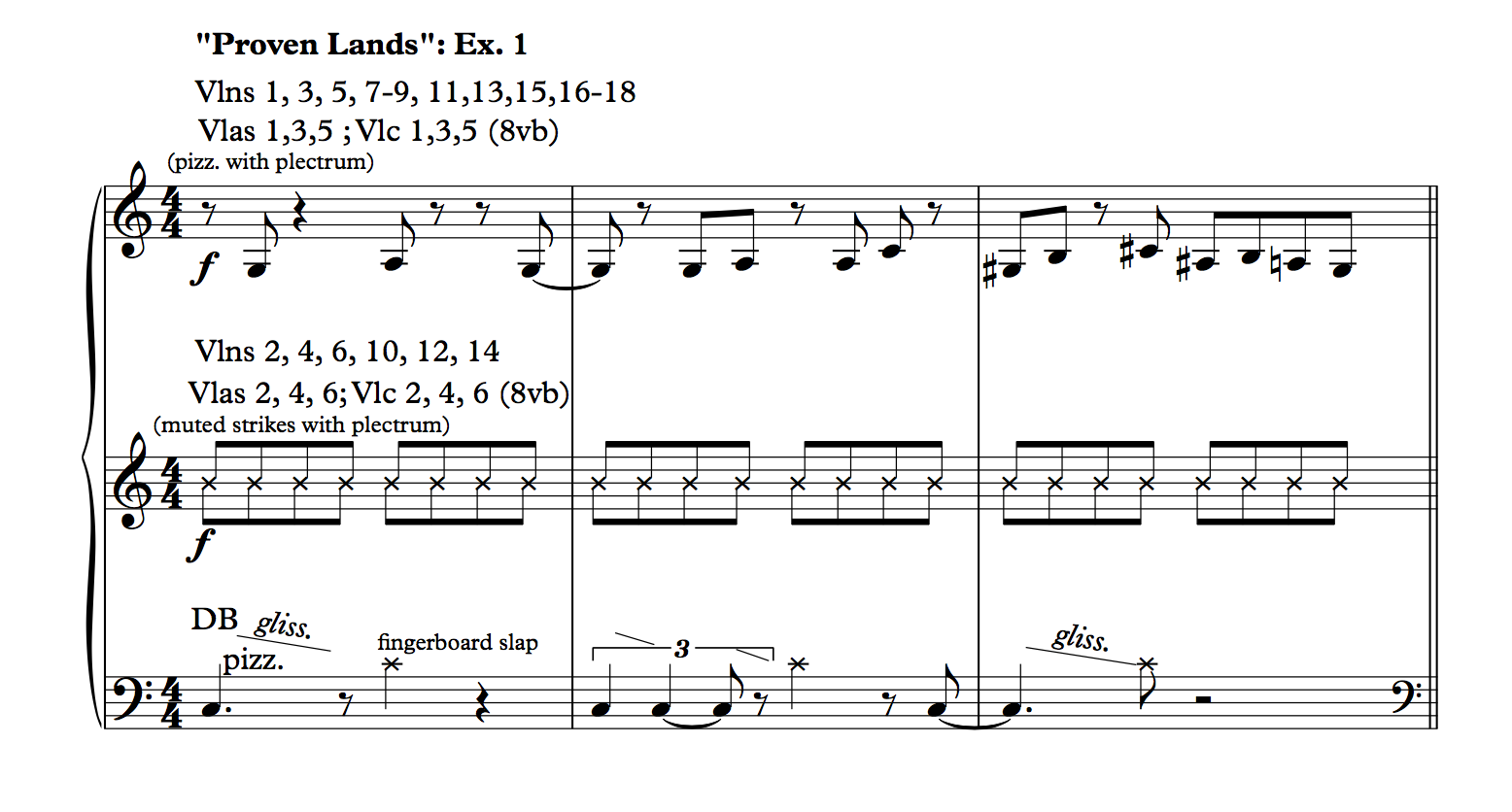
Greenwood assigns each line to players individually. For example, the first line is played in unison by “Vlns 1, 3 , 5 ,7-9, 11, 13, 15, 16-18,” by “Vlas 1, 3, 5,” and “Vlc 1, 3 and 5” (an octave lower). The melodic material here is chromatic and, in this excerpt it comprises the pitches G, G#, A, A#, B, C, C#. Note that these pitches can be seen as a melodic disposition of a cluster.
The overall effect of this bowing technique called col legno, may sound familiar if you’ve heard Radiohead’s “Burn the Witch.” The grainy, percussive materiality of the string section conveys a sense of turmoil, of things rushing quickly past — and the aleatoric nature of the melodic line seems to bounce around unexpectedly, with no direction or regular pattern, offering a glimpse of wayfaring and disorientation in the film.
In Example 2, taken from a later passage in the score (bar 23), the composer thickens and varies the lines in Example 1.
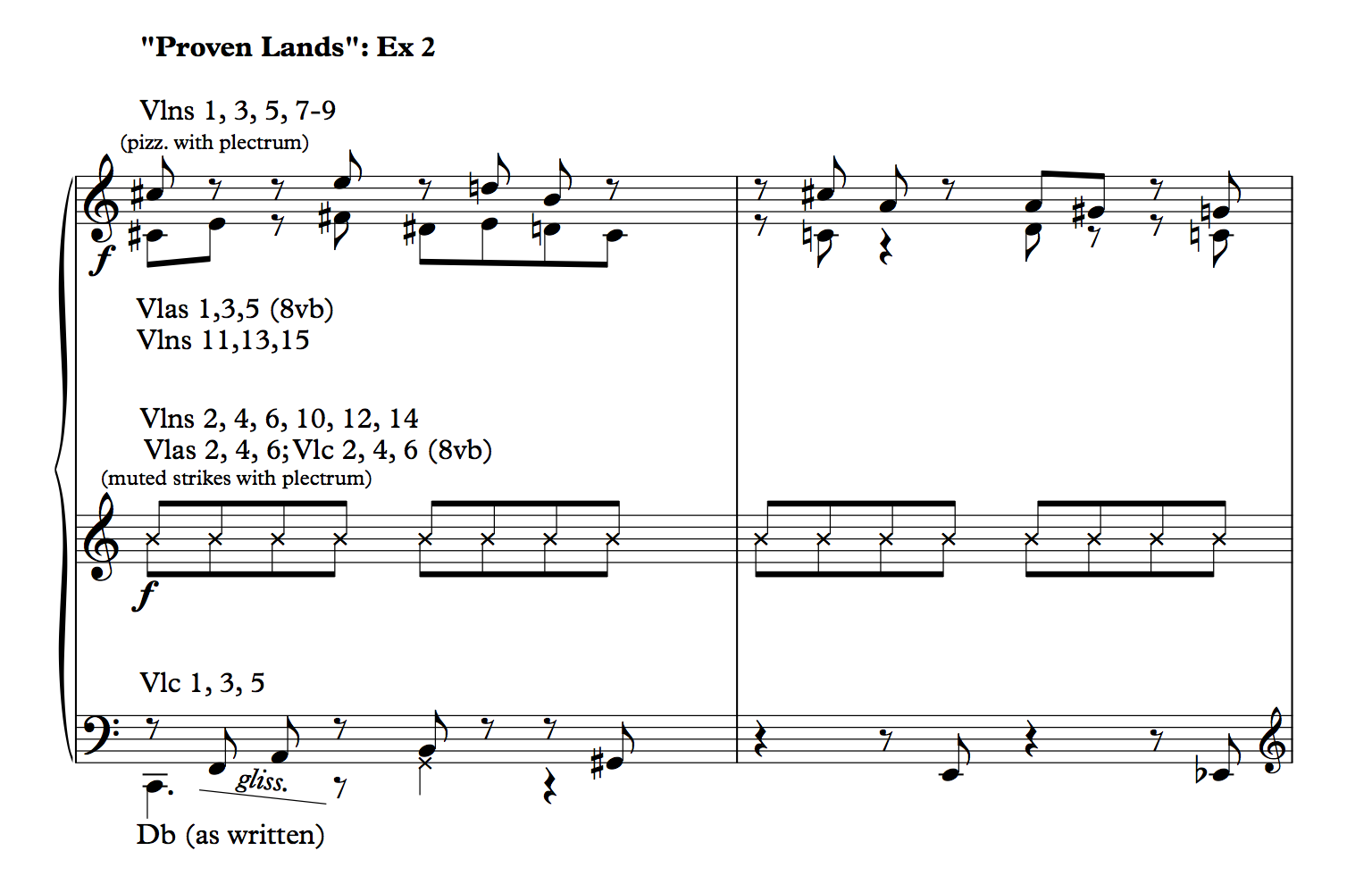
There are now two melodic lines instead of only one, while the muted line stays unvaried and the bass line is now assigned mainly to the cellos (“Vlc”). The melodic material here makes use of all the following pitches: C, C#, D, D#, E, F, F#, G, G#, A, B (and A# is used later on in bar 26). This time, Greenwood makes use of the total chromatic, expanding the material to a larger “cluster,” used melodically. The lines are arranged in a chromatic counterpoint, which gives the overall effect of being even more random and dissonant.
Finally, Example 3, taken from the end of the cue, shows another development in the material: a variation of the rhythmic ostinato from Example 1 is now used, in replacement of the three lines in Example 2.
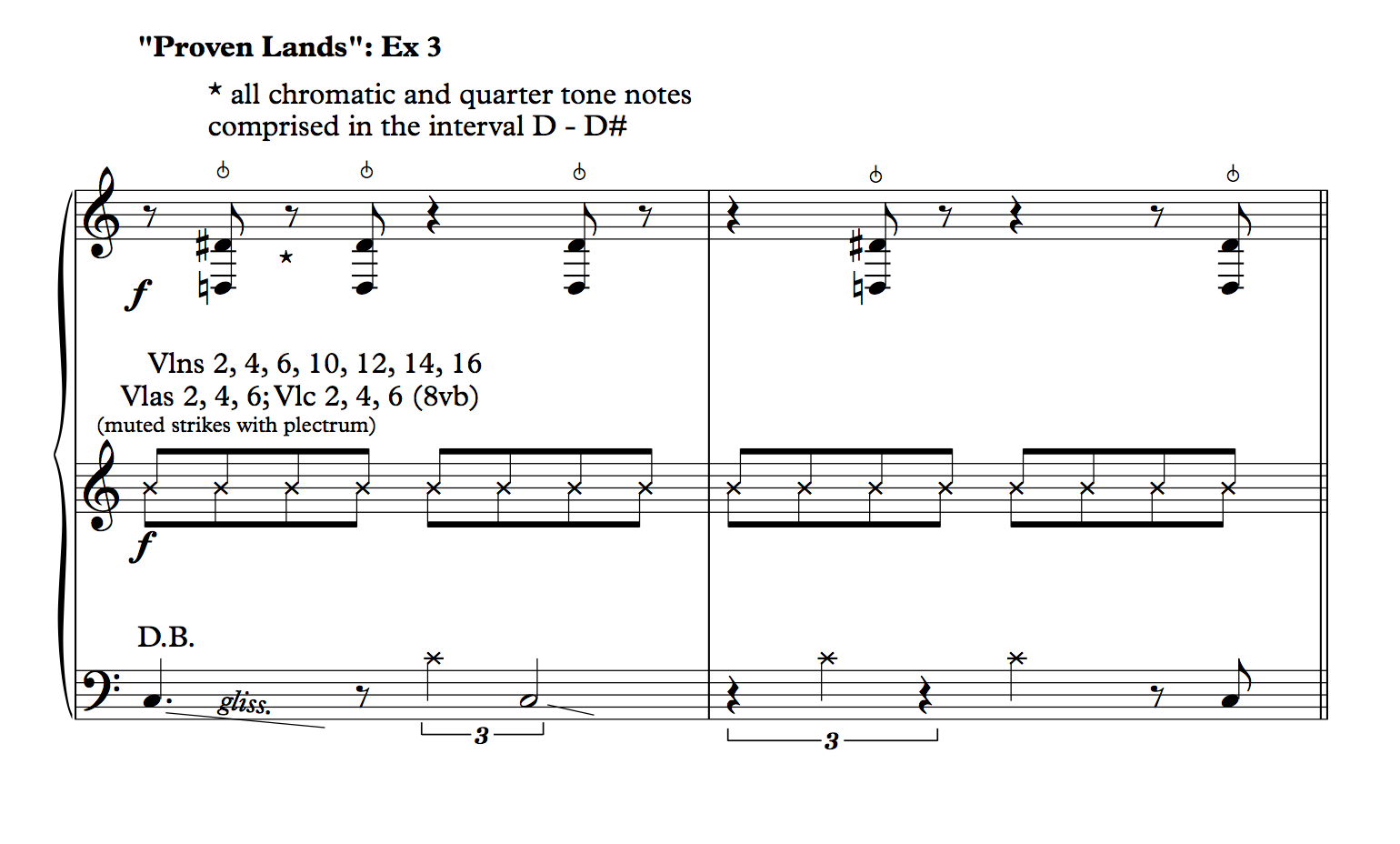
The percussive line in the middle staff stays unvaried and the line in the double bass is just more rhythmically active. What changes here is that all the remaining instruments are now playing an ostinato in rhythmical unison, though their pitches add to a cluster spanning over an octave from D to D# (a minor ninth above). These pitches are assigned to the remaining instruments in the string orchestra in a similar fashion to what Greenwood did in “Henry Plainview.” Notice the use of Bartok pizzicato to further enhance the roughness in the overall timbre.
It might not be quite considered “leitmotif,” at least in the traditional sense, but the music is responsible for so much of the emotional heavy lifting of this film, it’s almost more communicative.

Phantom Thread
Greenwood’s most recent score for Anderson is Phantom Thread, the story of Reynolds Woodcock, a famous London-based design stylist and tailor, and his relationship with Alma, a waitress who falls in love with him and becomes his wife. The movie deals with topics such as psychological attachment and draws a parallel between the thread used by the stylist to tailor his dresses and the psychological thread, the bond that ties he and Alma to each other.
During the years that separate his first score for Anderson from this most recent one, Greenwood seems to have changed his approach to scoring, away from more experimental styles and toward a more classic feel. In the cue “House of Woodcock,” the main theme is scored for piano, with embellishments by strings and harp.
Here’s my reduction of the piano theme, which comes in after the introduction concludes.
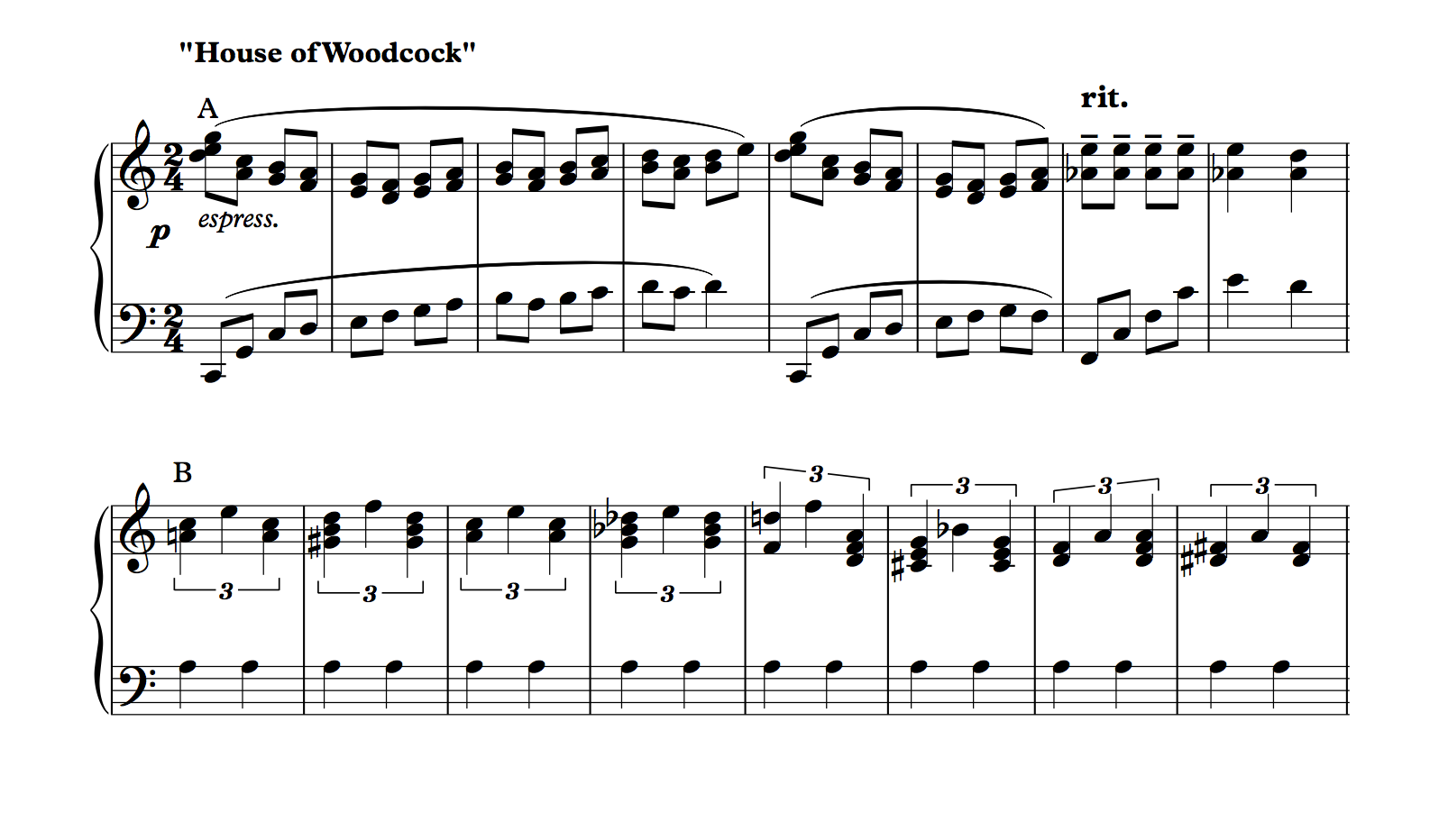
This choice of instrumentation, as well as in the melodic nature of this material, is reminiscent of French Impressionist composers Claude Debussy and Gabriel Fauré, whose pieces also appear in the soundtrack. His use of thirds as the main compositional bricks of this passage is redolent of Debussy’s “Claire De Lune” and gives it a lush quality. Additionally, this can be interpreted as evocative of elegance and lightness, concepts also related to haute couture fashion.
The first half of the cue (theme “A”) is constructed on a C major scale, with a change to Fmin(maj7) and D with no third in the end. The second half of the theme (“B”) is also constructed with thirds, this time on a pedal in A minor (the relative minor of C) with some neighboring and passing chords. The triplet feel also gives momentum and propels the second part of the theme.
With some imagination, his stream of thirds evokes, if not musically then perhaps visually, a thread that links the two contrasting themes.
The cue “Phantom Thread II” also corroborates this impression: The notes G and C are played with an unmeasured tremolo, again its own type of “thread” which links the various parts of the melody. For this piece, I used the transcription written out by Scribd user Larry067.
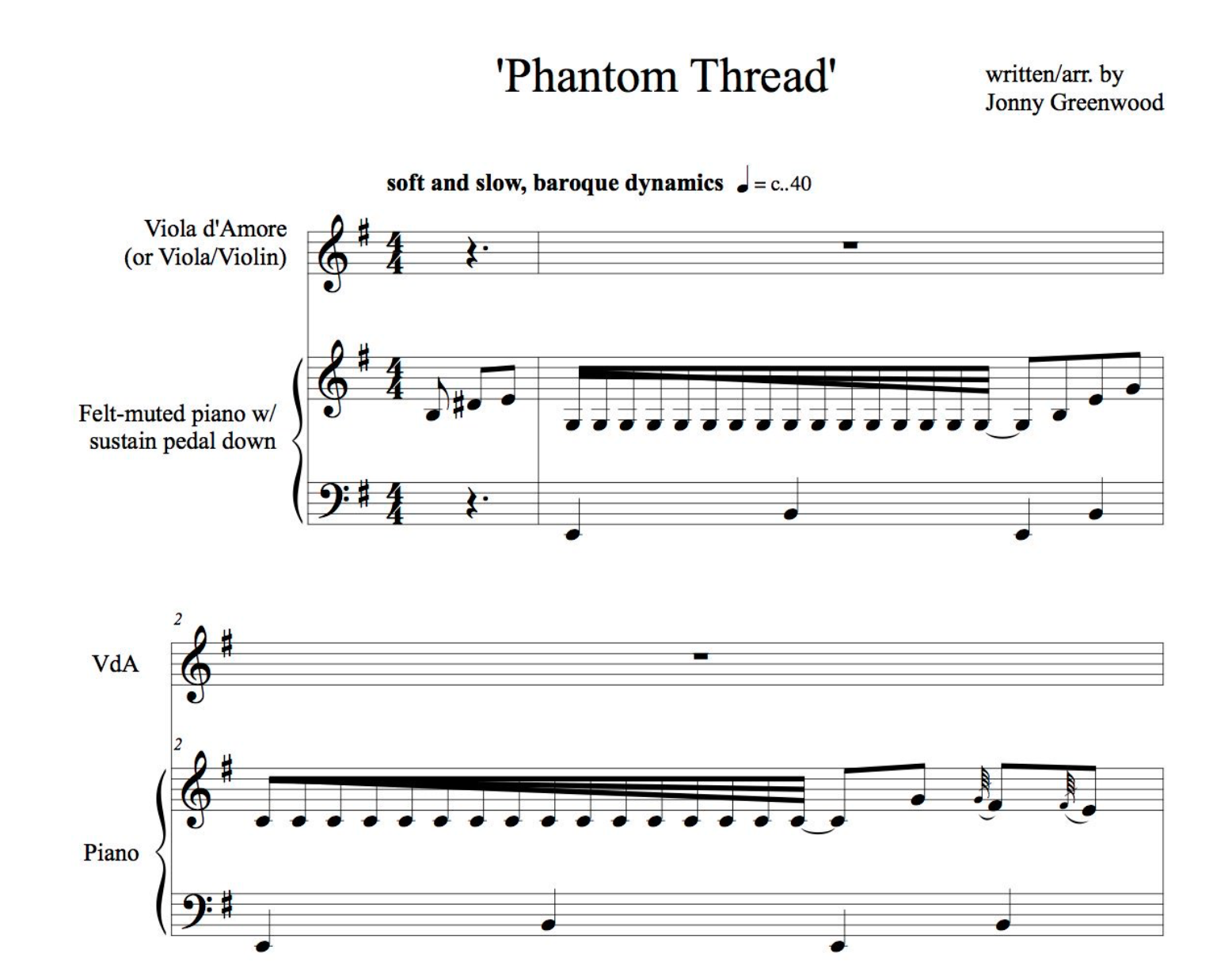
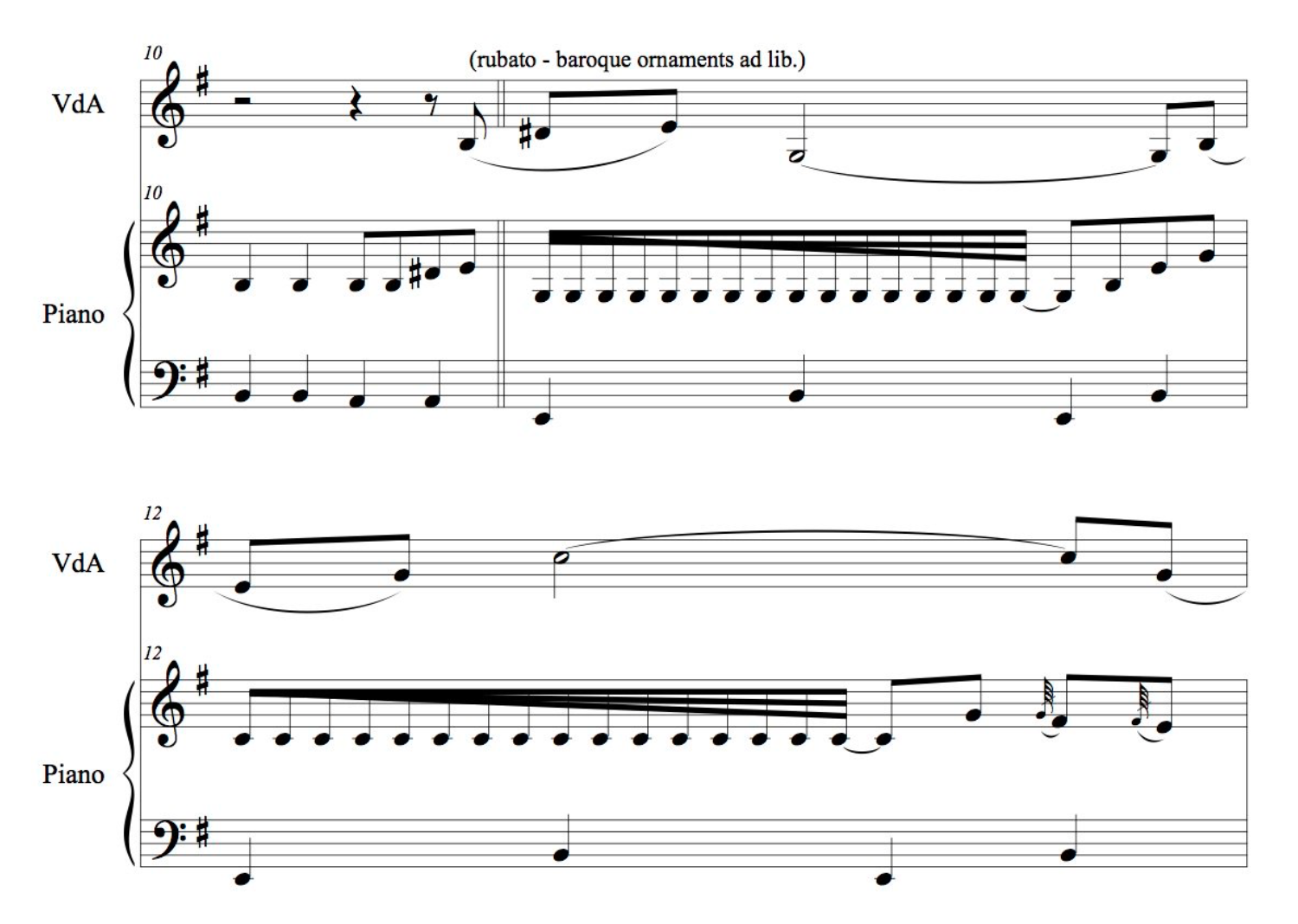
The cue is written in E minor (with a little inflection on E harmonic minor) and is played by a felt-muted piano, giving the instrument a muffled sound. This choice shows that Greenwood is still very sensitive to the use of timbre and the fact that he uses felt to mute the beaters gives that velvety quality to the sound, resulting in a natural roll-off of the high frequencies of the instrument, as well as another materialistic analogy to texture (in this case, fabric).
Over this design, Greenwood uses a viola d’amore, a 7-stringed baroque instrument used by 17th century composers such as J.S. Bach. The instrument gives an antique feel to the overall sound and makes use of non-written ornaments, customary of that era.
But back to timbre, when you listen back to that cue, although historically piano and viola pair extremely well together, there’s an evident disconnect between the sounds of these two players. The felt-muted piano is soft, hushed, trepidatious, whereas the viola’s timbre is sharp, biting, perhaps dominant. If you’ve seen the film, you may already know that the two main characters skirt fine psychological lines of power dynamics despite upholding the outward illusion of being in love.
The scores to both these films are strikingly different. They show Greenwood’s path as a composer evolving from a more experimental, contemporary approach to the work, to a more well-rounded “canonical” outlook.
Nevertheless, his interest in exploring timbre and the materiality of instrumental sound has never left the forefront. Using sounds that scratch, hit, pluck, and dampen, and evoke confusing or soothing emotions are some of his preferred means of creating a musical counterpart to the setting, locale, and environments of each film. As the scores unfold, we can almost feel the dusty, rocky quality of the environment in There Will Be Blood as well as the velvety, elegant fabrics of Woodock’s dresses in Phantom Thread, despite what psychological chasms lay just beneath the surface.
Have you checked out Soundfly’s courses yet?
Continue your learning with hundreds of lessons by boundary-pushing, independent artists like Kimbra, Ryan Lott & Ian Chang (of Son Lux), Jlin, Elijah Fox, Kiefer, Com Truise, The Pocket Queen, and RJD2. And don’t forget to try out our intro course on Scoring for Film & TV.
